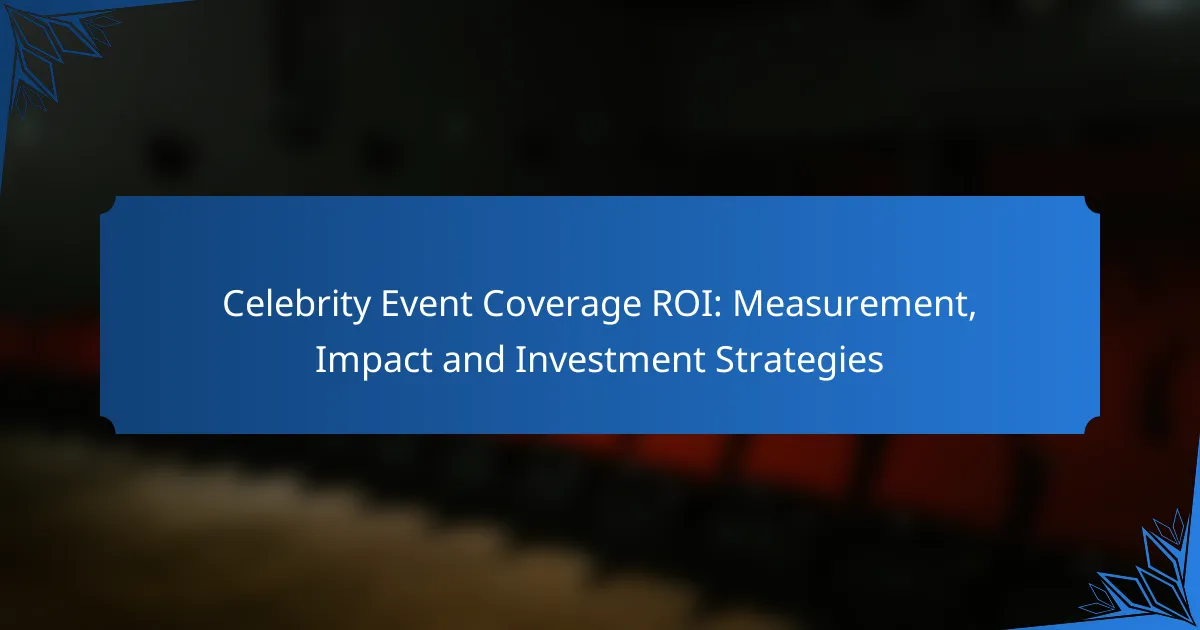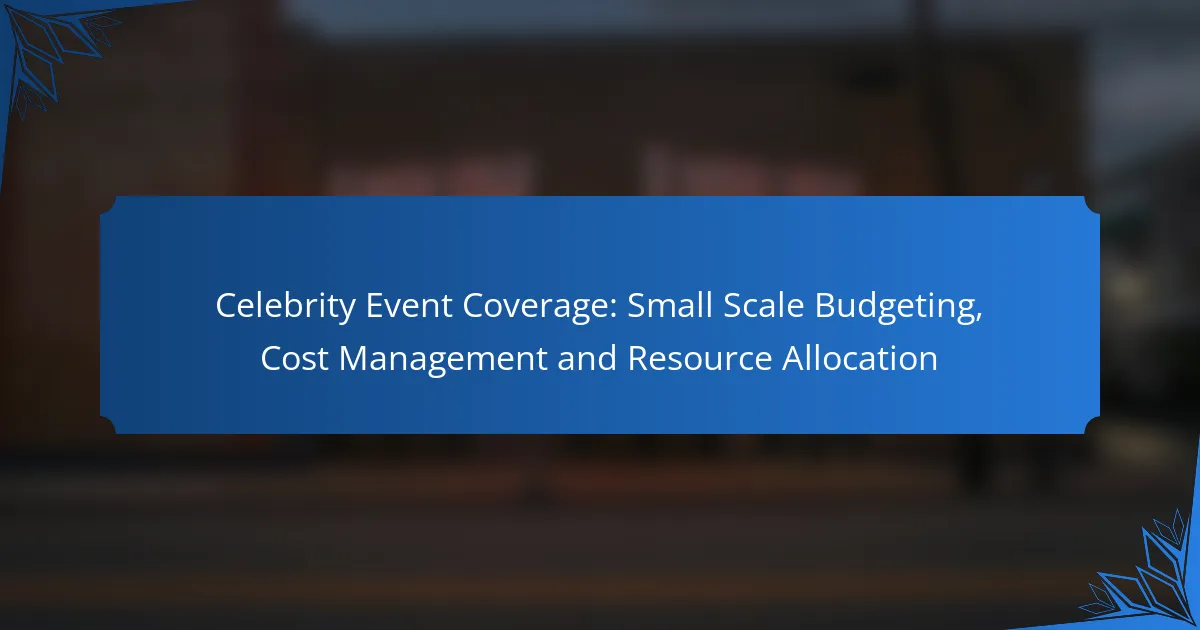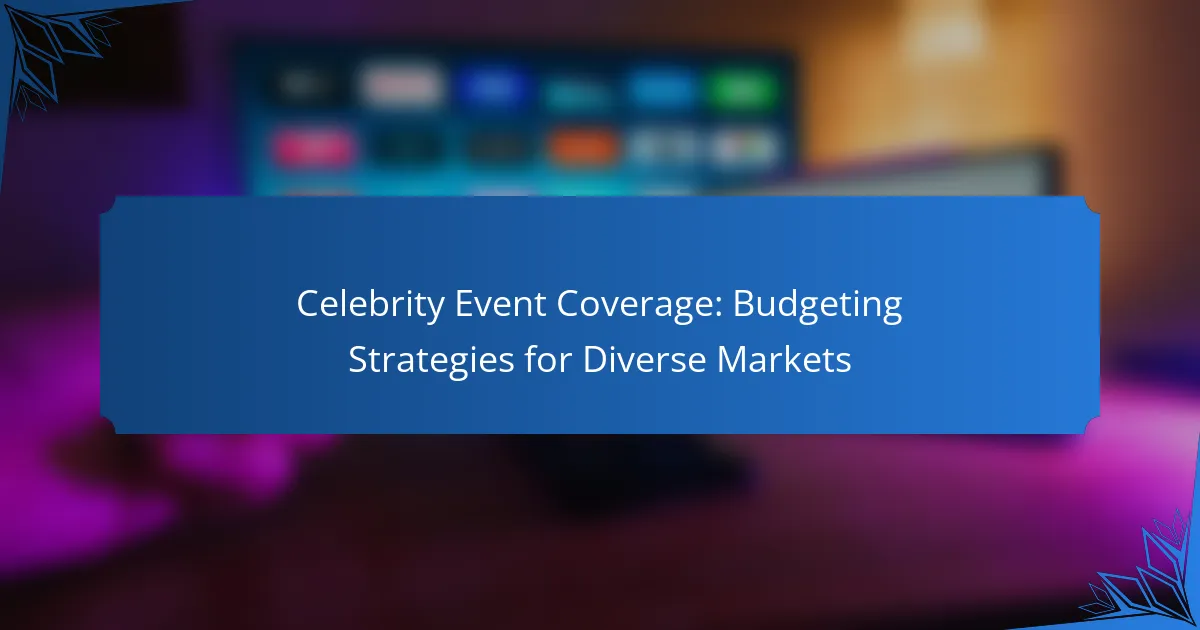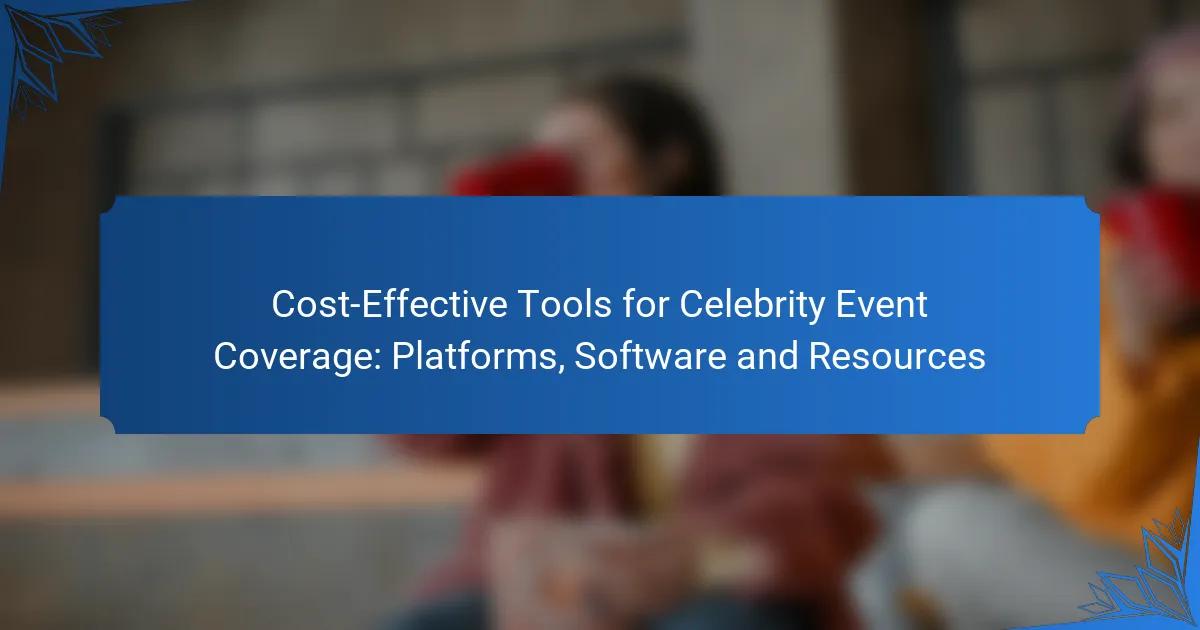Celebrity event coverage offers brands a unique opportunity to enhance their visibility and engagement through the influence of high-profile personalities. By measuring key metrics such as audience reach and conversion rates, businesses can evaluate the financial return on their investments and understand the overall impact of these events. Strategic investment in targeted advertising and influencer partnerships is essential to maximize ROI and ensure effective audience engagement.
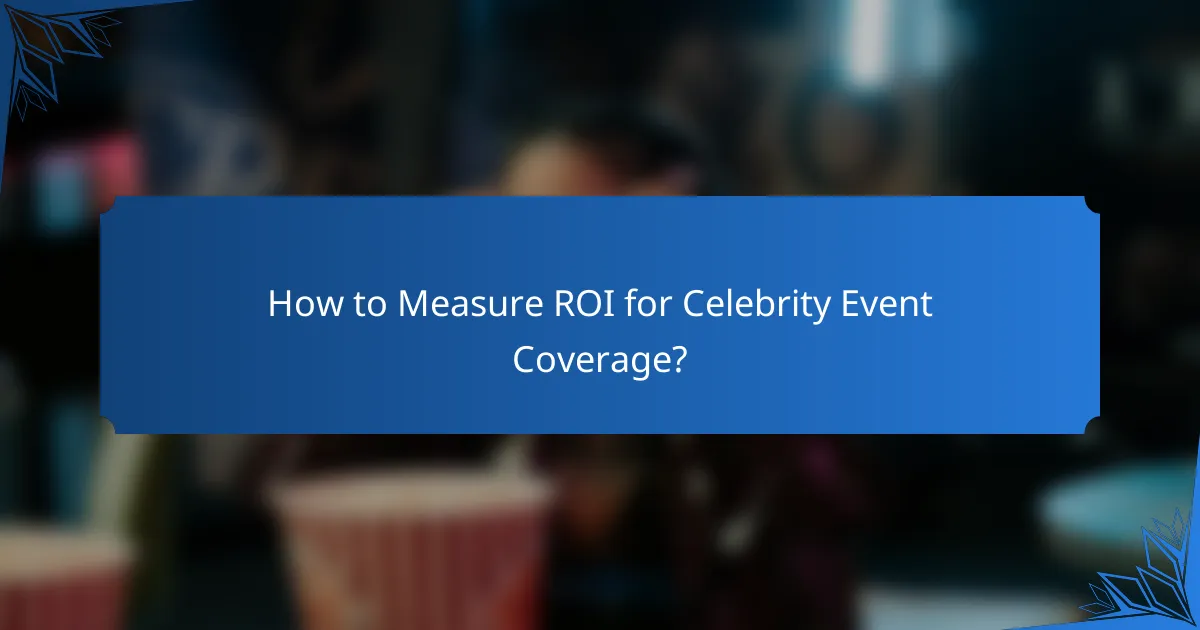
How to Measure ROI for Celebrity Event Coverage?
Measuring ROI for celebrity event coverage involves evaluating the financial return relative to the investment made in the event. Key metrics include engagement levels, audience reach, and conversion rates, which together provide a comprehensive view of the event’s impact.
Utilizing analytics tools
Analytics tools are essential for tracking the performance of celebrity event coverage. Platforms like Google Analytics and social media insights can provide valuable data on user interactions, traffic sources, and audience demographics. Choose tools that align with your specific goals, whether that’s website traffic, social media engagement, or sales conversions.
Integrating these tools allows for real-time monitoring, enabling quick adjustments to strategies based on performance trends. Regularly review the data to identify patterns and optimize future campaigns.
Engagement metrics analysis
Engagement metrics such as likes, shares, comments, and video views are critical for assessing audience interaction with celebrity event coverage. High engagement rates generally indicate a strong connection with the audience, which can lead to increased brand loyalty and awareness.
Consider setting benchmarks based on industry standards or past events to gauge success. For instance, a typical engagement rate for social media posts can range from 1% to 5%, depending on the platform and audience size.
Cost-per-impression evaluation
Cost-per-impression (CPI) measures the cost incurred for each time an ad or content piece is viewed. This metric helps assess the efficiency of your investment in celebrity coverage. Calculate CPI by dividing the total cost of the campaign by the number of impressions generated.
A lower CPI indicates a more effective reach, while a higher CPI may suggest the need for strategic adjustments. Aim for a CPI that aligns with your budget and expected outcomes, typically ranging from a few cents to several dollars, depending on the platform and audience targeting.
Audience reach assessment
Assessing audience reach involves measuring the total number of unique viewers exposed to your celebrity event coverage. This metric is crucial for understanding the potential impact of your investment. Utilize tools that provide insights into both organic and paid reach across various channels.
Consider the demographics of your audience to ensure alignment with your target market. A successful campaign should aim for a reach that significantly exceeds your typical audience size, ideally increasing by at least 20% during major events.
Conversion tracking methods
Conversion tracking is vital for determining how effectively your celebrity event coverage drives desired actions, such as purchases or sign-ups. Implement tracking pixels and UTM parameters to monitor user behavior post-engagement.
Set clear conversion goals and regularly analyze the data to assess performance. A conversion rate of 2% to 5% is generally considered good in many industries, but this can vary based on the nature of the event and the audience targeted.

What is the Impact of Celebrity Event Coverage on Brand Awareness?
Celebrity event coverage significantly enhances brand awareness by leveraging the influence of high-profile personalities to reach broader audiences. This exposure can lead to increased recognition, engagement, and ultimately, consumer loyalty.
Increased social media engagement
Celebrity event coverage often results in heightened social media engagement as fans and followers interact with content featuring their favorite stars. Brands can see engagement rates increase by several percentage points during major events, as users share, comment, and react to posts related to the coverage.
To maximize this engagement, brands should create shareable content, such as behind-the-scenes videos or live updates, that resonates with the audience. Utilizing popular hashtags associated with the event can further amplify reach and visibility.
Boost in website traffic
Coverage of celebrity events can lead to a notable boost in website traffic, as interested consumers seek more information about the brand’s involvement. This spike in visits can range from low tens of percent to even higher, depending on the event’s scale and the brand’s promotional efforts.
To capitalize on this traffic, brands should ensure their websites are optimized for user experience, with clear calls to action and relevant content that keeps visitors engaged. Implementing tracking tools can help measure the traffic increase and understand user behavior during these peak times.
Enhanced brand visibility
Participating in celebrity events enhances brand visibility by associating the brand with popular figures and high-profile occasions. This visibility can translate into increased media coverage, as journalists and influencers often highlight brands involved in such events.
Brands should consider strategic partnerships or sponsorships that align with their values and target audience to maximize this visibility. Additionally, creating press releases and engaging with media outlets can further enhance exposure and solidify the brand’s presence in the market.

What Investment Strategies Maximize ROI in Celebrity Event Coverage?
Maximizing ROI in celebrity event coverage requires strategic investment in targeted advertising, influencer partnerships, and careful budget allocation. These strategies help ensure that marketing efforts effectively reach the desired audience and generate measurable returns.
Targeted advertising campaigns
Targeted advertising campaigns focus on specific demographics and interests to enhance engagement and conversion rates. By utilizing data analytics, brands can identify their ideal audience and tailor their messaging to resonate with them. For instance, using social media platforms allows for precise targeting based on user behavior and preferences.
To maximize effectiveness, consider allocating a portion of your budget to A/B testing different ad formats and messages. This approach helps identify what resonates best with your audience, ultimately improving ROI. Aim for a balanced mix of traditional and digital channels to broaden reach.
Partnerships with influencers
Collaborating with influencers can significantly boost visibility and credibility during celebrity events. Influencers often have established trust with their followers, making their endorsements more impactful. Choose influencers whose audience aligns with your target market to ensure authentic engagement.
When forming partnerships, consider offering exclusive content or experiences that influencers can share with their followers. This strategy not only enhances the event’s reach but also creates a sense of urgency and excitement. Monitor engagement metrics to evaluate the effectiveness of these collaborations.
Budget allocation for high-profile events
Effective budget allocation is crucial for maximizing ROI in high-profile events. Prioritize spending on areas that directly contribute to brand visibility and audience engagement, such as event sponsorships, premium advertising slots, and influencer partnerships. A well-planned budget should also include contingencies for unexpected costs.
Consider the potential returns of investing in high-profile events versus smaller, niche events. While high-profile events may require larger investments, they often provide broader exposure. Regularly review and adjust your budget based on performance metrics to ensure optimal resource allocation.
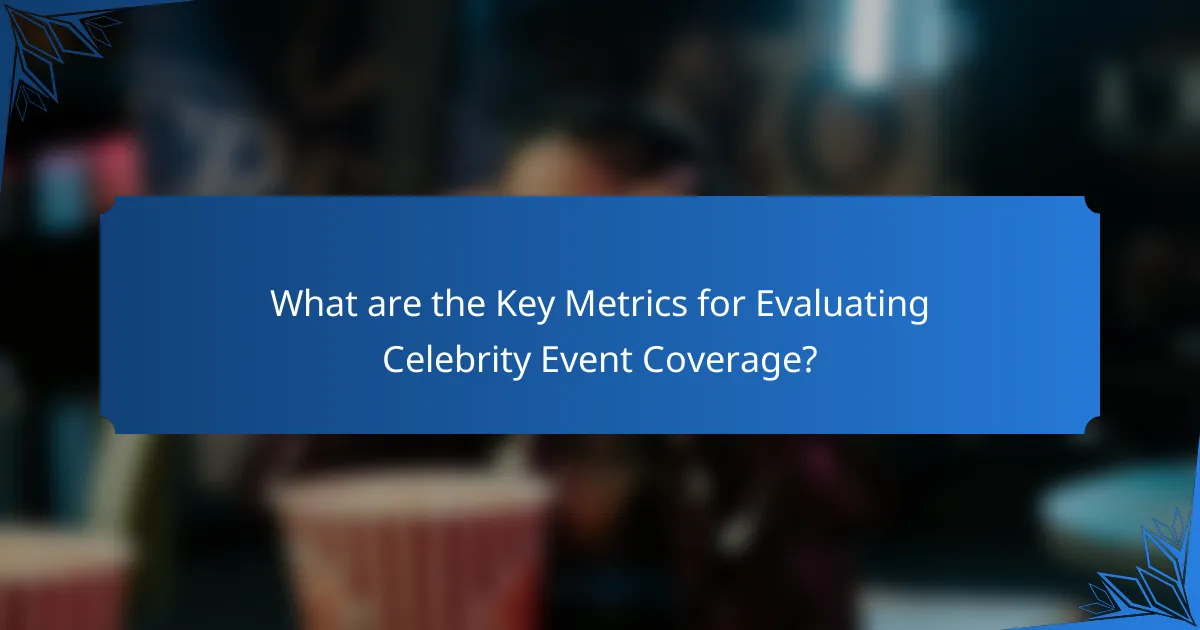
What are the Key Metrics for Evaluating Celebrity Event Coverage?
Key metrics for evaluating celebrity event coverage include return on ad spend (ROAS), brand sentiment analysis, and audience demographics insights. These metrics help businesses assess the effectiveness of their investments in celebrity endorsements and event sponsorships.
Return on ad spend (ROAS)
Return on ad spend (ROAS) measures the revenue generated for every dollar spent on advertising during a celebrity event. A typical ROAS benchmark might range from 4:1 to 10:1, depending on the industry and campaign goals.
To calculate ROAS, divide the total revenue generated from the event by the total advertising spend. For example, if a brand spends $10,000 on ads and generates $50,000 in revenue, the ROAS would be 5:1. Regularly tracking this metric can help refine future advertising strategies.
Brand sentiment analysis
Brand sentiment analysis evaluates public perception of a brand before, during, and after a celebrity event. This can be done through social media monitoring, surveys, and sentiment analysis tools that gauge positive, negative, or neutral reactions.
To effectively measure sentiment, consider using a combination of qualitative and quantitative methods. For instance, analyze social media mentions and comments to identify trends in consumer feelings. A positive shift in sentiment can indicate successful celebrity engagement.
Audience demographics insights
Audience demographics insights provide valuable information about the characteristics of the event’s viewers, including age, gender, location, and interests. This data helps brands understand who is engaging with their content and how to tailor future campaigns.
Utilize analytics tools to gather demographic data from social media platforms and event attendance records. For example, if a significant portion of the audience is aged 18-24, brands may choose to focus their marketing efforts on platforms popular with that demographic, such as TikTok or Instagram.
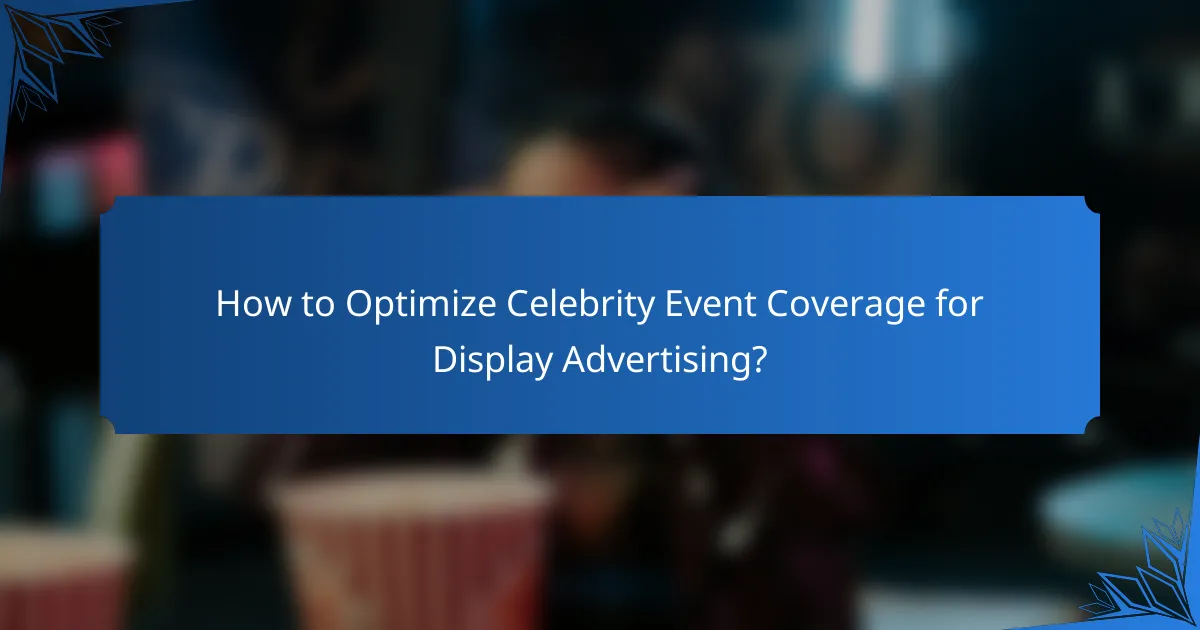
How to Optimize Celebrity Event Coverage for Display Advertising?
To optimize celebrity event coverage for display advertising, focus on leveraging high-impact visuals and engaging content that resonates with your target audience. Consider the timing and placement of your ads to maximize visibility and engagement during key moments of the event.
Creative ad formats
Utilizing creative ad formats can significantly enhance the effectiveness of your display advertising during celebrity events. Options like video ads, interactive banners, and rich media can capture attention more effectively than standard static ads.
For instance, video ads showcasing highlights from the event or behind-the-scenes content can engage viewers and encourage shares. Interactive formats, such as polls or quizzes related to the event, can also increase user interaction and dwell time.
When selecting ad formats, consider the platform and audience preferences. For example, social media channels may benefit from short, eye-catching videos, while websites might be more suited for immersive rich media experiences. Always test different formats to determine what resonates best with your audience.
